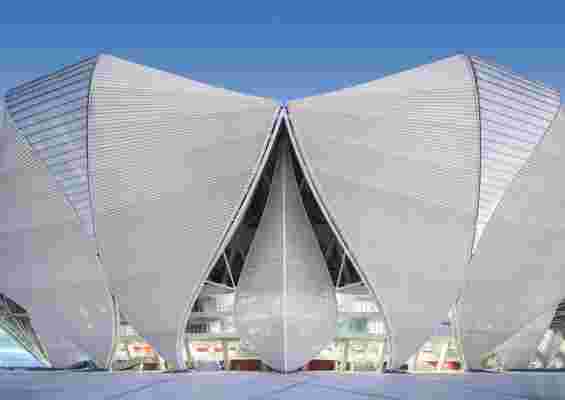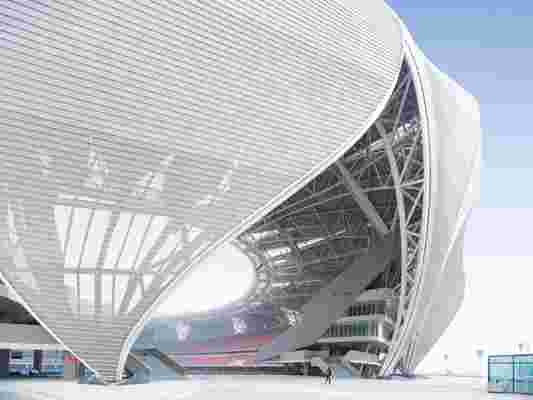With dozens of massive sports arenas across the country, China is by no means a stranger to the world of impressive stadium design—take, for instance, Beijing’s iconic Bird’s Nest. But the newest stadium addition impresses not only with its inspired design but also with its approach to sustainable architecture.
In need of additional public space for sporting events, Hangzhou, the capital city of Zhejiang province, sought to build new facilities—the result is the Hangzhou Olympic Sports Center, designed by Los Angeles-based architecture firm NBBJ, which comprises an 80,000-seat arena, a 10,000-seat tennis court, swimming pools, and retail space.

The stadium’s design was inspired by water lilies.
“Hangzhou is one of the most scenic cities in China, and its West Lake is renowned for its beauty, elegance, and unique foliage,” says NBBJ partner Robert Mankin. “The stadium draws upon this beauty by using the indigenous water lily, or lotus, of the West Lake as its conceptual inspiration, interpreting the form into a series of modular ‘petal’ structures that gracefully surround the stadium.”
While steel is a necessary component in stadium architecture—and it does play a prominent role at the Hangzhou Olympic Sports Center—it’s also a major cause for concern from a sustainability perspective. In 2018, the production of each ton of steel resulted in the creation of two tons of carbon dioxide. So from the get-go, NBBJ was tasked with reducing the amount of steel used in the structure. Though the Hangzhou Olympic Stadium is roughly the same size as the Beijing National Stadium, the iconic Bird’s Nest from the 2008 Olympics, it uses 60% less steel—approximately 16,000 tons versus 40,000 tons.

The stadium is as large as the Bird’s Nest in Beijing.
“The design team achieved this reduction in two ways: by linking the steel shell and concrete seating bowl together at each level so the two systems worked in unison, and by providing additional structure at the top of the bowl to reduce the roof cantilever,” says Mankin.
The ultimate resource for design industry professionals, brought to you by the editors of Architectural Digest

There’s also the matter of the plaza surrounding the stadium, which NBBJ also aimed to keep as eco-friendly as possible. “The overall planning of the complex makes use of porous, light-colored surfaces and green park spaces with maximum vegetation,” says Mankin. “This approach will greatly reduce water runoff from the site, and will avoid the heat sink challenges that most other sports centers in China, including the Beijing Olympic Plaza, experience.”
The steel shell is paired with a concrete seating bowl.
The Hangzhou Olympic Sports Center is now open to the public and is expected to encourage new (and hopefully sustainable) development in the rapidly growing city. “The special role that the Hangzhou Olympic Park will play in creating a civic center for the surrounding community based upon sports and wellness is perhaps the most exciting and unique aspect of the development,” says Mankin.
